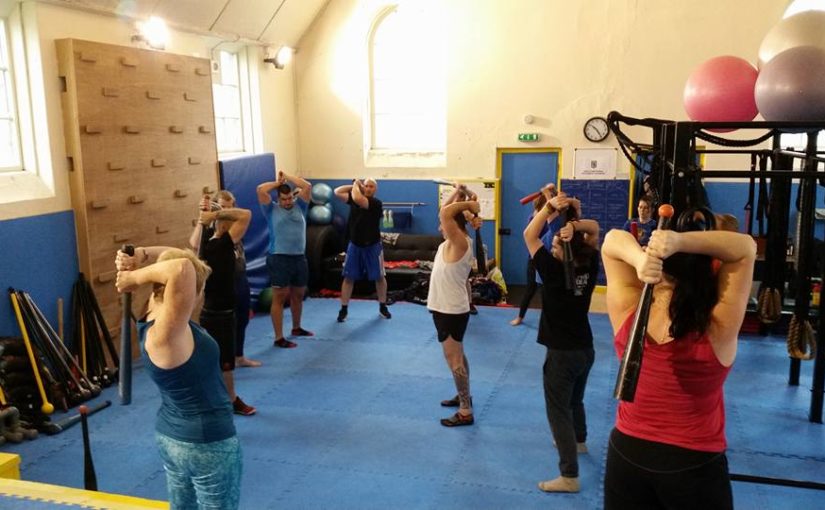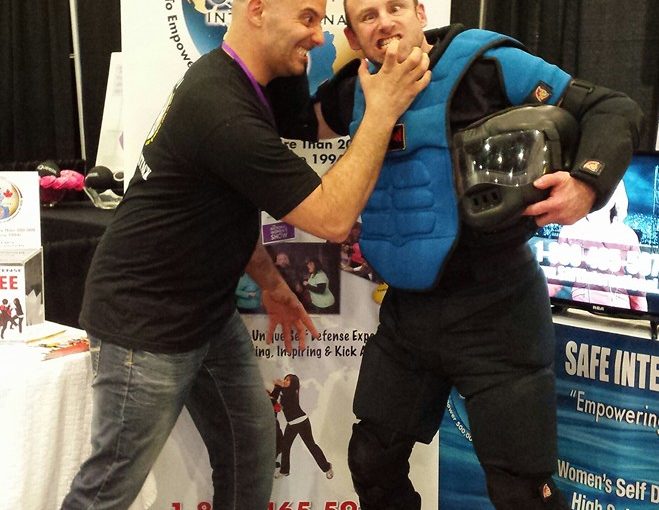In this article I write as a self-defense instructor about the mistakes in communications people make in dealing with a hostile person who are testing them verbally with insults etc. in order to see how they respond and if they are a safe victim to assault.
But what we are dealing with here really is human beings and the ‘Wild Kingdom’ we all really live in. I have lived in more than one world in that I was bouncer/cooler in the mid-seventies in a very large and fight prone bar in New Mexico. At the same time I was a High School Mathematics teacher in that desert community too. Later I left teaching in public schools and started a software company that was reasonably successful.
In that work I interfaced with IBM and Hewlett Packard at many different levels of authority and responsibility. I am not at all exaggerating when I say that working in that bar as bouncer, in terms of learning how to better communicate with hostile and aggressive patrons to avoid violence; well to be frank that skill served me well in the business world too.
I was actually surprised to see the extent to which there was so little shared goals by the people in both big firms. Mostly managers and such were first concerned with distancing themselves from any anticipated future problem or crisis. It was politics and self-interest that first motivated most managers and even some higher level executives.
This was real drag on productivity too. And at its root was failure in communications. Few managers wanted to be the one that fist announced a big problem coming up, as then they feared that they would ‘own the problem’. This was not a universal attitude, but any chain of communications is no better than its weakest link.
Remember that there are truly only three types of communications 1-Aggressive and Demanding 2-Passive and subservient and 3- Assertive and effective. But let’s look closer here. In ‘Aggressive and demanding then the person is ‘talking’ to a subordinate. Just as subordinate is receiving that communication or failure at same from a ‘Superior’.
This is similar to responding with FEAR or ANGER at an aggressive person, and that person could be the one assuming the role of the ‘superior’, as in a ‘bully in the bar’ or a ‘pushy’ middle manager. When we respond with either fear or anger we have not chosen our path, we are allowing our biochemistry that is a million years old do the choosing for us!
The only response that is our choice and our decision is to be assertive in the face of aggression.
Now please understand all of this exists on very long continuum. For example, in a prison environment a convict may kill another convict for being ‘disrespected’ or ‘dissed’. In an office situation a manager my fire an ‘insolent’ or ‘disrespectful employee’.
It is mostly the consequences that are radically different in the two examples here, and not the nature of the communication. Both the manager and the ‘homicidal convict’ acted out of a communication that was received as being ‘disrespectful’.
Effective communications can make guy who intends to pound your face into raspberry jam and has articulated that intention to you into a person who decides he does not have to or want to do that. This is no ‘theory’ with me it is experience. And yes, not all such people can be verbally de-escalated but most in my experience can be.
Likewise middle manager or boss who is ‘chewing your ass out royally’ and maybe even in front of others in the office, well if you handle it very well you can sometimes communicate with him or her in productive manner to. By ‘productive’ I mean in way that ‘solves’ or ‘begins to solve’ the problem the ‘Boss’ is chewing you out for. Neither anger nor fear can ever accomplish this. But measured assertiveness might.
So let’s get down to specifics here. Below is truncated version of my newsletter to subscribers whose main interest is self-defense, but true self-defense exists on very long continuum too, from the barroom to the boardroom as I have been in both places good people. I will also say that self-defense is subset of self-improvement and the most powerful form of same I am aware of too when done authentically.
Even martial arts, which is not really self-defense training at least in any comprehensive way, has some real self-improvement benefits too.
Hence below in italics I will give examples of the mistakes people make in dealing with a potentially assaultive bully, to the mistakes and consequences of dealing with the office and corporate environment. If you live in the same worlds I do then you surely know there are disagreeable people there too you must communicate with and yes, even bullies as well.
1- They fail to recognize the intent of the abusive person’s verbal attack behaviors.
The bully’s intent is to determine if a physical attack on you is safe for them or not. In short, you are being ‘interviewed ‘for safe victim potential. The verbal attack and insults and challenges are an ‘interview” of you
Same deal with overbearing manager, once they see they can abuse you one way or another they are encouraged to do so. EXAMPLE” The Boss tells a subordinate to have the Johnson report ready by Friday at 10 AM. The subordinate knows it can be done in that time and the software is not set up for the format he wants. SUBORDINATES FEAR RESPONSE: They say nothing and are not communicating the problem and thus they are worried and unproductive all the way to Friday and then the Boss discovers the people coming in from out of town he will be much less prepared to meet and sell. This could be the last straw for the boss and subordinate well catch Hell and may be terminated.
2- They are in Denial that the verbal assault is really happening
The most common way this is done is just by ignoring the abuser as if he were not there. This means you pass his interview for ‘safe victim potential’ and it’s now much more likely he will get physical\ and attack you. The bully needs to inflate his self-esteem through abusing others with impunity. This is because of his actual weak self-image.
The Boss has not communicated that the situation properly. The subordinate does not realize the gravity of having the report being ready for the important Friday meeting. The subordinate knows that the Boss is always making near impossible demands and time frames and ‘he will just have to learn what is possible and isn’t possible’ Friday.
3- They get angry and return his insults
To the experienced ‘human predator’ this is very close to #3 above. He knows fear and anger are almost the same thing in such a situation. You are also helping him get his courage up to attack you. It is like throwing gasoline on fire to put it out. Showing anger is escalating the situation and shows him he is ‘getting to you’ which to some extent means he is succeeding in controlling you.
To the Boss this is insubordinate and disrespectful and he or she won’t have it. The Boss may terminate the subordinate and find someone in the department that can perform the job rather than complain.
5- They verbally challenge the aggressor
How stupid is this? Both make themselves tactically open for attack. This is ‘Wild Kingdom’ stuff and neither person is really in control of themselves or they would not do this non-sense
Similar to getting angry, it isn’t a rational choice by the subordinate but an emotional response. The subordinate may seem calm but is saying “Boss we have been through this before. The software does not allow the information to be selected and printed out like that and certainly not by Friday you should be aware of these things by now”. In this communication the subordinate as far as the Boss is concerned is just telling him or her what the subordinate can’t do. This is not of interest as much as what the subordinate CAN DO in the time frame. Further the accusation that “you should be aware of these things by now” is insulting and challenging and may be seen easily as being disrespectful and the subordinate being person that is just too hard to deal with and him or she just does not need that.
6-They display an Ignorance of what is happening. If you show fear, indecision and ignorance of the situation then you might say something like: “Hey leave me alone I haven’t done anything to you”. Of course he knows all that already, you have just told him “I am afraid and I do not understand why your acting this way to me as never have dealt with this before and so you can be sure I do not know how to handle it now if you go physical with me”
Here the subordinate is taken off balance by the Boss’s demand. This is partly both parties fault too at that point. The subordinate then will be asking ‘what ifs’ or “are you saying that we have too” or “look it’s not my responsibility to be able to do something the system isn’t programmed to do”. Again the subordinate is communicating to the Boss that it is ‘His problem’ not theirs and what once again simply what ‘can’t be done’. The boss needs a replacement that accepts responsibility and knows there job, this person is headed for potential unemployment.
7- They care what people around them will think about them and let that fear determine their actions.
Suppose you are with friends or your girlfriend or wife when you are confronted by a bully in restaurant. If you are worried or concerned that IF you don’t meet this hostility with ‘manly action’ you will be seen as a coward then you are not in control of yourself, someone else is! If this passes through your mind then you are afraid that you are ‘not really a man’ in the first place and that is the real problem. You are acting like an adolescent boy not a man. Either you are in control of yourself or someone else is. Of course showing fear and freezing up is no good either, it encourages the bully.
The Boss chooses to ‘chew the subordinate out’ in front of other co-workers. This is very seldom by anything but the Boss’s design and purpose so as to amplify the castigation of the subordinate. It is basically the same dynamic communication wise as the dealing with the Bully in the restaurant. The assertive response is best as it discourages the Boss from doing this as it does not met his result does not meet his expectation. An assertive but not insubordinate response might be “Mr. Boss I realize the importance of this problem and we need to go to your office to discuss some sensitive elements of this problem”. If this continues do you really want to work there anyway? WE spend a great really enormous a lot of our life at work. What kind of life do y6ou want? All endings are always also the start of new beginning.
8-They allow themselves to become triggered by ‘Name Calling’. This one is both the more challenging to explain physiologically and for many the most challenging response to disengage from. Being ‘triggered’ exists on a continuum. The trigger for a Black Person might be being called the “N” word. Yet the trigger for another person might be something as simple as being called “Sport”. When “triggered’ a person can respond automatically and immediately and thus not under their own self-aware will and rational control.
The OODA loop: concept:
Observation, Orientation, Decision, Action. This is a very key concept to understand. Decision-making occurs in a recurring cycle of observe-orient-decide-act. An entity (whether an individual or an organization) that can process this cycle quickly, observing and reacting to unfolding events more rapidly than an opponent, can thereby “get inside” the opponent’s decision cycle and gain the advantage.
AN Example: Again I am just having a beer on a Harley bike trip through Colorado and New Mexico when I am aware that a guy at a table by himself has the ‘hard eyes’ on me. I judge him to be a ‘regular’ there .I am of course just passing through. I had an unusually strong sense of malice about this guy and possible mental problems. I decided to pre-empt. I smiled at him and sat down at his table and said in a friendly manner “Don’t I know you form “D Block in La Tuna?” La tuna was a prison in New Mexico the State I was now in. He was derailed. His OODA loop was broken.
In the example by asking him this questions about ‘was he not someone I saw in prison’, I interrupted his decision loop and derailed it. He was surprised and told me he had been in jail before but never prison.
I replied he had been ‘smart then’ and wished him well and went back to the bar to have lunch. This was one of those rare incidents where pre-preemption was best and so I went with my gut feeling there.
OK, how does this idea of the OODA Loop apply to business? The short answer is “in every possible aspect of business”. This is because business is about people and commutations and sales in particular is about anticipating and being able to preemptively engage objections to the sale. Now do not say to yourself “But I am not in sales”. Yes you are in sales every human being on the planet is in sales one way or another really regardless of what they do for a living.
One way to grasp this is this idea: A Doctor sells medical services a Lawyer legal service a Plumber fixing your leaking pipes and overflowing toilet services, a politician sells himself in nearly every conceivable way imaginable, a would be lover of another is selling him or herself to that significant other, or would be significant other or spouse as a suitable mate. The list is of course endless.
To the management or CEO you are selling him or her the idea that you are valuable asset to the enterprise. Ok we don’t necessarily think of it those terms or idioms, but isn’t this idea about ‘sales’ a reality?
That is where the OODA Lop and mastering its intricacies with people and prospects becomes paramount. Sales of any kind is mainly the business of educating the prospect to the sale the ‘how and why’ he or she needs your service or product. Of course that ‘prospect’ may be your boss, the CEO, the manager that can promote you or even the person you are hoping to sell a piece of real estate too).
So you want to anticipate objections so you can resolve them in the mind of your sales prospect. Yet the objections to any sale are always one of these three
1-NO NEED, I do not have the problem you solve so I do not need you or you or service or
2-NO HELP, I realize I have a problem but you dot really understand what that problem is so your solution does not apply to me, it is no help.
3- NO HURRY: Hum, I have the problem, your solution seems to fit, but we have gotten along this far without it so there is no hurry to make a decision right now.
You should be prepared to get inside the mind of your prospect OODA Loop wise. This means you know the problem the prospect has as well or better than he or she does. It means you know thus exactly what the benefit you or your solution provide. And for objection number three, NO HURRY, you should be able to meaningfully project to the prospect what it is costing them daily or monthly or yearly just what it is costing them not to have you or your service or product right now.
https://www.youtube.com/watch?v=2V7JwS8d_X8









